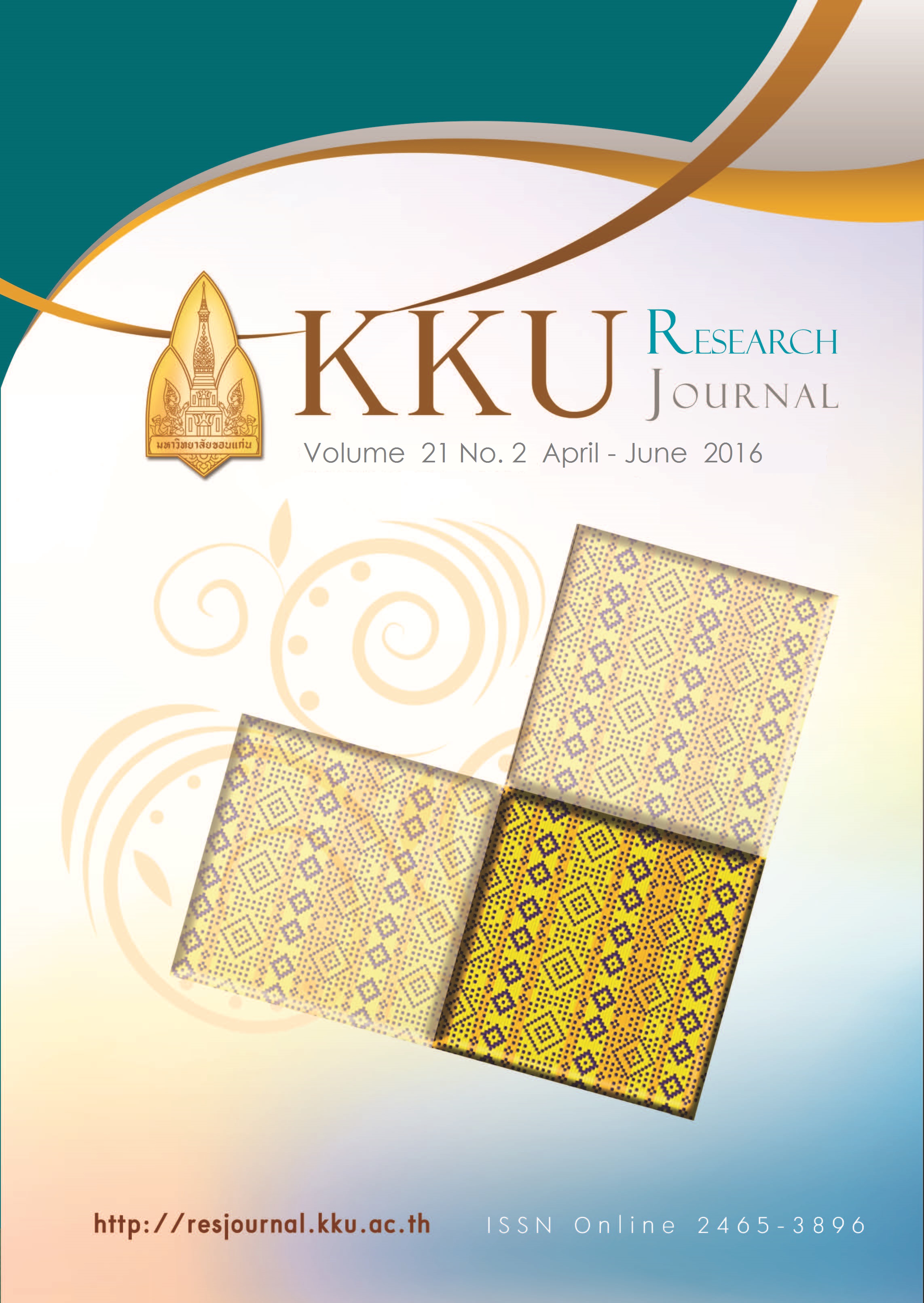Zymomonas mobilis biofilm formations on different types of carriers
Main Article Content
Abstract
Zymomonas mobilis biofilm have been proposed to enhance the bioethanol production from agricultural derived materials. Z. mobilis biofilm reactor has been prospected to be used for a large scale bioethanol production. The cost effective carrier for Z. mobilis biofilm reactor was searched. This study investigated the biofilm forming abilities of Z. mobilis strain TISTR 551 and ZM4 on biotic (loofah and corn silk) or abiotic carriers (flatted sheet polyvinyl chloride, PVC). Biofilm formation was visualized for 3 consecutive days under the bright-field microscope. Only Z. mobilis TISTR551 represented the biofilm forming ability on corn silk under the microscopic observation, while no biofilm formation on loofah and PVC was observed. The mature biofilm was developed on day 3. The biofilm formation was also quantitatively analyzed based on the weight differentiation of the carrier and the carrier with the bacterial attachment. The net biomass weight of TISTR 551 and ZM4 on corn silk carrier was 0.6 ±0.1 g and 0.33± 0.1g respectively. Therefore, corn silk illustrates its potential to be used as a cost effective biocarrier for Z. mobilis biofilm.
Article Details
References
[2] Franden, M.A.,Pilath, H. M., Mohagheghi, A., Pienkos, P. T., & Zhang, M. Inhibition of growthof Zymomonas mobilis by modelcompounds found in lignocellulosic hydrolysates. Biotechnology for Biofuels, 2013. 6: p. 99.
[3] Li, X.Z.,Webb, J. S., Kjelleberg, S., and Rosche, B. Enhanced benzaldehyde tolerance in Zymomonas mobilis biofilms and the potential of biofilm applications in fine-chemical production. Applied and Environmental Microbiology, 2006. 72(2): p. 1639-44.
[4] Todhanakasem, T.,Sangsutthiseree, A., Areerat, K., Young, G. M., & Thanonkeo, P. Biofilmproduction by Zymomonas mobilis enhancesethanol production and tolerance to toxicinhibitors from rice bran hydrolysate. New
Biotechnology, 2014.31(5): p. 451-9.
[5] Cheng, K.-C., A. Demirci, and J.M. Catchmark, Advances in biofilm reactors for production of value-added products. Applied microbiology and biotechnology, 2010. 87(2): p. 445-456.
[6] Rosche, B., Li, X. Z., Hauer, B., Schmid, A.and Buehler, K., Microbial biofilms: a concept for industrial catalysis? Trends in biotechnology, 2009. 27(11): p. 636-643.
[7] Chandel, A.K., Li, X. Z., Hauer, B., Schmid,A., and Buehler, K.Bioresource technology, 2007.98(10): p. 1947-1950.
[8] Behera, S.,Kar, S., Mohanty, R. C., & Ray,R. C. Comparative study of bio ethanol production from mahula (Madhucalatifolia L.) flowers by Saccharomyces cerevisiae cells immobilized in agar agar and Ca-alginate matrices.
Applied Energy, 2010.87(1): p. 96-100.
[9] Yu, J., X. Zhang, and T. Tan, An novel immobilization method of Saccharomyces cerevisiae to sorghum bagasse for ethanol production. Journal of biotechnology, 2007. 129(3): p. 415-420.
[10] Kopsahelis, N.,Agouridis, N., Bekatorou, A. and Kanellaki, M,Comparative studyof spent grains and delignified spent grains as yeast supports for alcohol production from molasses. Bioresource technology,2007. 98(7): p. 1440-1447.
[11] Riansa-ngawong, W., M.Suwansaard, and P. Prasertsan, Application of palm pressed fiber as a carrier for ethanol production by Candida shehatae TISTR5843. Electronic Journal of Biotechnology, 2012.15(6): p. 1-1.
[12] Kunduru, M.R. and A.L. Pometto III, Continuous ethanol production by Zymomonas mobilis and Saccharomyces cerevisiae in biofilm reactors. Journal of industrial microbiology, 1996. 16(4): p. 249-256.
[13] Todhanakasem, T., Narkmit, T., Areerat, K., & Thanonkeo, P. Fermentation of rice bran hydrolysate to ethanol using Zymomonas mobilis biofilm immobilizationon DEAE-cellulose. Electronic Journal of Biotechnology, 2015.18(3): p. 196-201.
[14] Chandel, A.K., Narasu, M. L., Chandrasekhar, G., Manikyam, A., & Rao, L.V, Use of Saccharumspontaneum (wildsugarcane) as biomaterialfor cell immobilization and modulated ethanol production by thermotolerant Saccharomyces cerevisiae VS 3. Bioresource technology, 2009. 100(8): p. 2404-2410.
[15] Reddy, L.V.,Reddy, Y. H. K., Reddy, L.P.A., & Reddy, O. V. S. Wine production bynovel yeast biocatalyst prepared by immobilization on watermelon (Citrullusvulgaris) rind pieces and characterization of volatile compounds. Process Biochemistry, 2008. 43(7): p. 748-752.
[16] Kunduru, M.R. and A.L. Pometto III, Evaluation of plastic composite-supports for enhanced ethanol production in biofilm reactors. Journal of industrial microbiology, 1996. 16(4): p. 241-248.
[17] Linger, J.G., W.S. Adney, and A. Darzins, Heterologous expression and extracellular secretion of cellulolytic enzymes by Zymomonas mobilis. Applied and Environmental Microbiology, 2010. 76(19): p.6360-6369.


